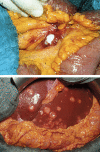Multimodal management of neuroendocrine liver metastases
- PMID: 20662787
- PMCID: PMC3028577
- DOI: 10.1111/j.1477-2574.2010.00175.x
Multimodal management of neuroendocrine liver metastases
Abstract
Background: The incidence of neuroendocrine tumours (NET) has increased over the past three decades. Hepatic metastases which occur in up to 75% of NET patients significantly worsen their prognosis. New imaging techniques with increasing sensitivity enabling tumour detection at an early stage have been developed. The treatment encompasses a panel of surgical and non-surgical modalities.
Methods: This article reviews the published literature related to management of hepatic neuroendocrine metastases.
Results: Abdominal computer tomography, magnetic resonance tomography and somatostatin receptor scintigraphy are widely accepted imaging modalities. Hepatic resection is the only potentially curative treatment. Liver transplantation is justified in highly selected patients. Liver-directed interventional techniques and locally ablative measures offer effective palliation. Promising novel therapeutic options offering targeted approaches are under evaluation.
Conclusions: The treatment of neuroendocrine liver metastases still needs to be standardized. Management in centres of expertise should be strongly encouraged in order to enable a multidisciplinary approach and personalized treatment. Development of molecular prognostic factors to select treatment according to patient risk should be attempted.
Figures



References
-
- Williams ED, Sandler M. The classification of carcinoid tumours. Lancet. 1963;1:238–239. - PubMed
-
- Moertel CG. Karnofsky memorial lecture. An odyssey in the land of small tumors. J Clin Oncol. 1987;5:1502–1522. - PubMed
-
- Caplin ME, Buscombe JR, Hilson AJ, Jones AL, Watkinson AF, Burroughs AK. Carcinoid tumour. Lancet. 1998;352:799–805. - PubMed
-
- Kulke MH, Mayer RJ. Carcinoid tumors. N Engl J Med. 1999;340:858–868. - PubMed
-
- Modlin IM, Lye KD, Kidd M. A 5-decade analysis of 13 715 carcinoid tumors. Cancer. 2003;97:934–959. - PubMed
Publication types
MeSH terms
Substances
LinkOut - more resources
Full Text Sources
Medical
Miscellaneous

